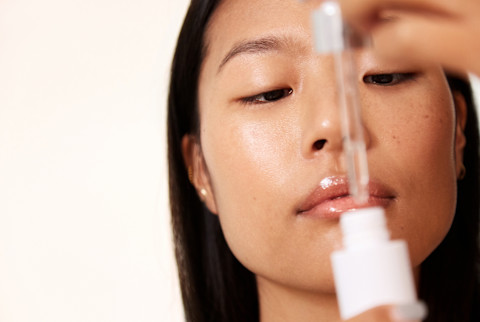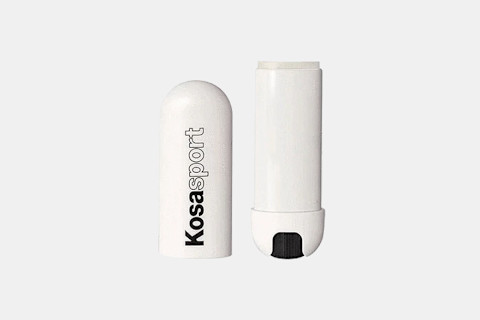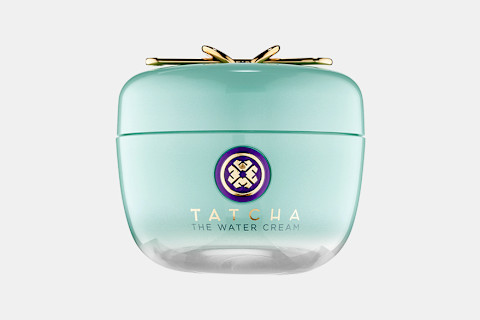Should Your Skin Care Change With Your Period? What A Holistic Derm Says

If you have a regular (or semi-regular) cycle, there's a decent chance you notice changes in your body throughout. This could be evident in bloating, your mood, or the dreaded breakouts. But period pimples are not the only way your period affects your skin: It can also make the skin appear drier, oiler, duller—or more glowy and dewy.
And the thing is, we're all different and our skin reacts differently to our internal rhythms. So perhaps this isn't a problem for you, in which case, keep along your merry way. But for some (well, a lot of people: Some 65% of women1 say their periods mess with their skin), if you notice that with your cycle comes vastly different skin conditions, you may consider making adjustments to your skin care routine based on the time of the month.
Now, before you get upset that we are demanding a whole new skin care regimen every week, don't worry: These are slight adjustments to your skin care regimen (adding a mask or toner here, subbing in a hydrating serum there), with no need for a dramatic overhaul.
Really what you're doing here is listening to your body and your skin's needs on any given day or week—and adjusting your routine to that.
How to sync your skin care with your cycle.
Your cycle goes in four major phases, each lasting about a week. These phases bring about different hormones and overall changes in the body. There are many ways you can notice these changes, and one is through the skin.
Now, everyone's exact cycle is different. So yours may not follow these days exactly (that's normal), but we provide them here as a rough estimate. You know your cycle better than we do, so listen to your body and try to glean what it's telling you.
Week 1: First day of your period.
With the first day of your period comes a very dramatic hormone drop. This drop results in less sebum production, as hormones are one of the primary regulators of oil in the body. Now, since the drop happens when your period starts, you may not really notice changes until a few days later. (Read: You may still have residual breakouts right when your period starts, but just know that's going to change.)
"During this phase, levels of estrogen and progesterone are at their lowest, which translates to a decrease in skin hydration and vulnerability of the skin barrier to irritation and inflammation," says board-certified dermatologist Keira Barr, M.D. "With both progesterone and testosterone also low, there is less sebaceous gland activity and oil production contributing to skin dryness. All this adds up to dry, dehydrated skin that may be more prone to irritation and inflammation, which is why conditions like atopic dermatitis, contact dermatitis, and psoriasis may be worse just before or during your period."
For some, this will be a welcome change: If your skin is naturally oil-prone, having a drop in production may be just what you are looking for. If your skin is on the drier side, this may mean flakes and irritation.
Depending on where you fall on the skin spectrum, proceed as necessary. You may need to add an extra layer of hydration (a thicker cream, for example, or top your lotion with an oil to seal it all in). If you're finding that reduced oil production is just what you need, embrace the dewy (not shiny) glow.
But for most people, you'll likely benefit from a touch more hydration right now. "Moisturizing with soothing and nourishing skin care ingredients, including hyaluronic acid, ceramides, gotu kola, and sea buckthorn oil can help minimize dehydrated skin," says Barr. "Also boosting your hydration with water, and foods rich in omega-3 fatty acids, vitamin C, and antioxidants to help ease inflammation and irritation."
Week 2: Days 7–13.
This phase of your cycle is when estrogen levels are more prevalent. "Estrogen2 is key to the normal functioning of the skin as well as the blood vessels, hair follicles, oil glands, and our pigment-producing cells called melanocytes. It is associated with collagen production3, increased skin thickness, increased hyaluronic acid production, improved skin barrier function, maintaining skin hydration, reduced sebaceous (oil) gland activity, and improved wound healing. It also plays a role in modulating inflammation4." Clearly, this is all good for your skin, making your complexion appear more plump, supple, and taut.
During this time, you may consider helping your skin with said collagen production (we have even outlined a whole collagen skin care plan here, if you are so curious.) This can include something as simple as taking a collagen supplement or adding a vitamin C serum to your daily routine. Vitamin C, you might know, is a vital part of the collagen synthesis process, and we need healthy levels in order to stabilize and produce collagen.
"This is a time to embrace your glow, take a break from makeup, but don't forget your moisturizer with SPF," says Barr. "Due to the higher levels of estrogen, and their role in pigmentation, you want to protect your skin from UV rays. Because the skin barrier function is likely to be at its highest during these phases, using products with more active skin care ingredients is better tolerated."
Try these products:
Week 3: Days 14–21.
During this phase we start to see more progesterone, a hormone that has many skin benefits, as well as some challenges. Progesterone is shown from research to increase dermal thickness (a good thing; healthy skin is thick skin) as well as elasticity. In fact, the hormone is so popular in the skin care space, it's even applied topically as a prescription-strength healthy aging cream, shown to reduce lines and improve texture5.
However, this is also when we start to see an uptick in sebum production as well. While this won't be cause for alarm for some, for those who are acne- and oil-prone might run into some issues, as their main concern is keeping oil to a minimum.
"On Day 14 there is a surge in luteinizing hormone (LH), which not only harkens a rise in progesterone, but testosterone peaks at Day 14, and these two hormones both contribute to increased sebaceous gland activity and oilier skin including an oily scalp and greasy hair," says Barr. "As estrogen levels are declining, there may be more inflammation, irritation, and disruption of the skin barrier and microbiome, which can also contribute to breakouts."
Try these products:
Week 4: Days 21–28.
This is when the body sees the most testosterone out of your whole cycle. This can be challenging for skin: "As progesterone and testosterone begin to increase making the skin more oily, skin care should focus on oil control for those who are more affected," says Barr.
Hormonal breakouts6 tend to localize around the jawline, so if you get your breakouts here, it's a pretty good indication that your acne is hormonal and period-related. Remember: There are several triggers for acne, not just your cycle. Significant research has linked testosterone to excess sebum production in women7 and therefore increases the chances of clogging pores and developing pimples for those who are genetically predisposed to acne.
If this sounds like you, now's the time to step up your skin care game. Consider doing a clarifying mask to help keep pimples in check, use a salicylic acid-based face wash, and (of course) remember to moisturize to keep hydration levels in check, so as not to spur oil overproduction.
"Adding in a toner and mattifying products may be helpful," says Barr. "Note of caution, though, not to be overzealous with active ingredients that strip the skin of oil because you may get compensatory secretion and make the problem worse. In addition to topical skin care, nourish your body with anti-inflammatory foods (i.e., keep added sugars and dairy products out of your pantry) as well as activities that will reduce inflammation like getting good sleep, stress-relieving activities like exercise, meditation, and connecting with friends and family."
7 Sources
- https://www.ncbi.nlm.nih.gov/pmc/articles/PMC4142818/
- https://pubmed.ncbi.nlm.nih.gov/11705091/
- https://www.ncbi.nlm.nih.gov/pmc/articles/PMC2685269/
- https://pubmed.ncbi.nlm.nih.gov/15948678/
- https://pubmed.ncbi.nlm.nih.gov/16120154/
- https://www.ncbi.nlm.nih.gov/pmc/articles/PMC6360964/
- https://www.ncbi.nlm.nih.gov/pmc/articles/PMC2923944/












